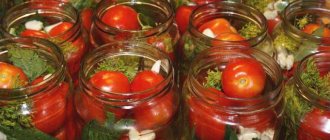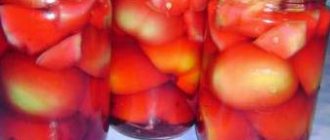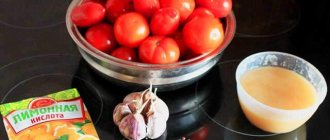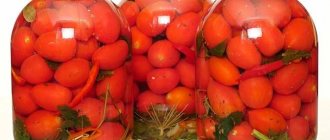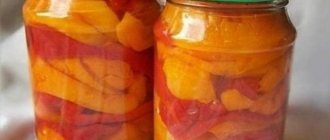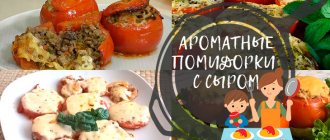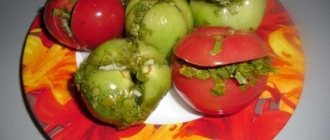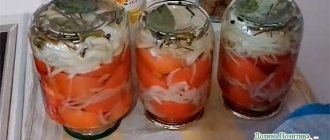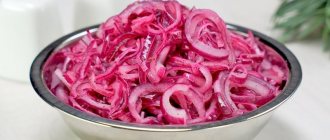Among other vegetables, tomatoes deservedly occupy one of the first places on the table, fresh and canned. A storehouse of the most useful lycopene, which, by the way, is preserved even after heat treatment, tomatoes perfectly retain their taste in preparations. It is enough to eat three tomatoes for the body to receive the daily requirement of a powerful antioxidant called lycopene. Tomatoes are good on their own or in combination with other vegetables. Below are recipes for canned tomatoes and parsley for the winter.
Subtleties of preparing tomatoes with parsley for the winter
Even one sprig of parsley can enrich the taste and aroma of a tomato preparation. However, like other greens, canned parsley requires very careful cleanliness - the slightest dirt on the leaves can cause damage to the canned food. In addition, there are other features of preparing preparations for the winter with tomatoes and herbs:
- When filling with brine, be sure to fill the jar to the very top, pouring liquid over its edge. The less air remains, the better the quality and safety of the product;
- It is better to put greens in sprigs, it looks more attractive. The exception is recipes where chopped greens are placed directly into tomatoes;
- Unless otherwise specified in the recipe, it is recommended to use vinegar essence in pickling rather than table vinegar. It gives greater safety to the product.
The filling volume is usually taken at the rate of half the volume of the jar.
How to choose and prepare vegetables and herbs?
Usually, fully ripe, juicy and largest tomatoes are chosen for food. It is better to take smaller tomatoes in a jar if the recipe does not specifically call for chopped vegetables. Here are some more tips for selecting and processing greens and vegetables:
- The jars contain tomatoes of the same ripeness, strong, although in general they can be ripe, unripe and even brown.
- The greens are taken juicy, bright, without yellow leaves or damage. Before laying, it is soaked to remove sand and dirt, washed several times and dried.
- Fleshy varieties of tomatoes with smooth, dense skin are preferable to thin-skinned ones, as they tolerate heat treatment better.
- To prepare whole vegetables, it is recommended to prick each fruit with a fork or toothpick before placing it in a jar. This will not damage their integrity, but will prevent them from cracking when pouring boiling water.
What to consider before salting
- Salted and pickled tomatoes are not the same thing. The difference is that in the first case salt is added to the liquid, and in the second case vinegar or citric acid is added.
- Previously, vegetables were salted in barrels or other large containers, but these days it is much more convenient to do this in glass jars.
- It is better to choose strong tomatoes. Too soft ones can simply creep apart during the salting process.
- Vegetables and herbs need to be washed, and jars and lids need to be sterilized or at least thoroughly washed with soda.
- The recipes are designed for a three-liter jar. It usually holds about 1½–2 kg of tomatoes and about 1½ liters of water. But it is better to determine the amount experimentally, especially if you want to pickle tomatoes in jars of a different size. Vegetables must be compacted tightly so that they do not float, and the jar must be filled with water to the very top.
- The amount of salt and sugar for brine is based on 1½ liters of water. If you need less or more liquid, change the amount while maintaining the proportions.
Video recipe for tomatoes for the winter is to die for
To prepare you will need 1 liter jar:
- Carrots - 3-4 rings.
- Onion -1/4 part.
- Parsley - a few sprigs.
- Tomatoes - required amount per jar.
- Bay leaf - 1 pc.
- Peppercorns -2 pcs.
- Garlic - 1 clove.
- Bite 70% - 1 teaspoon.
For brine per liter of water.
- Salt - 1 tbsp. heaped spoon.
- Sugar -3 tbsp.
Peel the carrots and onions and rinse under running water. We also thoroughly wash the tomatoes and parsley sprigs. I try to take tomatoes as small as possible. We sterilize the jars and boil the lids. Place several sprigs of parsley, onions and carrots cut into rings on the bottom of the jar. Pierce clean tomatoes with a fork and place in a jar. We also add a clove of peeled garlic. Pour boiling water over the tomatoes, wait a couple of minutes, drain the water, as if blanching. After that, put a bay leaf and a couple of peppercorns in each jar. Cook the brine, add salt and sugar to boiling water, mix thoroughly so that the sugar and salt crystals dissolve. Fill the tomatoes with brine and only then add vinegar to each jar. Roll up the lid, turn the jars upside down, and put them in a dark place for a day.
Preparations for the winter are not complete without canning tomatoes. Pickled tomatoes
in jars - a juicy and tasty winter snack.
We present you recipes for canning tomatoes
with various spices, bell pepper, dill, grapes, onions, garlic, carrot tops, in tomato juice.
Proven recipes, the most delicious tomatoes for the winter
, such pickles will be useful to any housewife.
A fragrant and juicy winter snack, tomatoes with grapes, looks beautiful. We prepare tomatoes without sterilization with the addition of vinegar.
Tomatoes, white and red grapes, 1 sprig of basil, 2 cloves of garlic, 1 onion, 2 cloves, 1 tbsp salt. l. without a slide, sugar 1.5 tbsp. l., vinegar 9% 1 tbsp. l.
Recipe
Prepare 1.5 liter jars and lids: wash and sterilize. Wash the tomatoes and grapes. To prevent the skin from bursting on the tomatoes, pierce the base of the tomato with a toothpick.
Peel the onion, cut into half rings, cut the garlic cloves in half. Place basil, chopped onion, garlic, and cloves at the bottom of each jar.
Place tomatoes in a jar with spices alternating with grapes. I added red and white grapes at the same time.
Pour boiling water over the jars of tomatoes and grapes, cover with lids and leave for 20 minutes.
Pour the brine into the pan and bring to a boil. Fill the tomato jars with brine again and leave for 20 minutes.
Pour the brine into a saucepan, add sugar and salt. Stir and bring to a boil.
Pour 1 tbsp into each jar of tomatoes. l. vinegar, then pour boiling brine and roll up the lids. Turn the jars upside down and leave until completely cool. Store in a cool place.
The best variety of tomatoes is Cream, which is not overripe. A simple recipe for delicious halved tomatoes for the winter.
Tomatoes 1.5 kg, dill, parsley, bay leaf, garlic, peppercorns, onions, vegetable oil 2 tbsp. l, vinegar 9% 4-6 tbsp. l.
Brine for a 3 liter jar:
sugar 6 tbsp. l, salt 2 tbsp. l, water 5 glasses 250 g.
Recipe for cooking tomatoes in halves for the winter
Wash the tomatoes, cut each in half. Prepare jars and lids, wash and sterilize.
At the bottom of the jar put parsley, dill, onion cut into half rings (half an onion is enough for a liter jar), bay leaf, 5-7 peppercorns.
Prepare the marinade:
Add sugar and salt to the water and bring to a boil. Remove the marinade from the stove and leave to cool to room temperature. Pour the cooled marinade over the tomatoes, cover with lids and sterilize.
Sterilize liter jars for 4 minutes, 1.5 liter jars for 5 minutes, 3 liter jars for 7 minutes.
Cover the jars with lids, turn them upside down and leave until completely cool.
How to pickle tomatoes
If you want to quickly enjoy salted tomatoes, slightly cover the jars with nylon lids and leave at room temperature for 4–7 days. The brine should become slightly cloudy. Then put the already tightly closed preparations in the refrigerator or cellar for 10–15 days. After this, the vegetables can be eaten.
If you are not in a hurry with tasting, then the closed jars can be immediately put into the refrigerator or cellar. They will be salted in one and a half to two months.
In any case, tomatoes can be stored for about six months, but it’s better not to delay it.
Salted tomatoes with herbs and garlic
Ingredients
- 2-3 dill umbrellas along with stems;
- 1–2 cherry leaves;
- 1–2 currant leaves;
- 2 leaves of horseradish;
- 4–5 cloves of garlic;
- 1½–2 kg tomatoes;
- 1½ liters of water;
- 3 heaped tablespoons of salt.
Preparation
Coarsely chop half the dill with scissors and place on the bottom of the jar. Place all the cherry and currant leaves, 1 horseradish leaf and half of the coarsely chopped garlic there.
Recipe: Tomatoes with parsley and garlic. Calorie, chemical composition and nutritional value.
Nutritional value and chemical composition of “Tomatoes with parsley and garlic.”
The table shows the nutritional content (calories, proteins, fats, carbohydrates, vitamins and minerals) per 100 grams of edible portion.
| Nutrient | Quantity | Norm** | % of the norm in 100 g | % of the norm in 100 kcal | 100% normal |
| Calorie content | 53.7 kcal | 1684 kcal | 3.2% | 6% | 3136 g |
| Squirrels | 2 g | 76 g | 2.6% | 4.8% | 3800 g |
| Fats | 2.5 g | 56 g | 4.5% | 8.4% | 2240 g |
| Carbohydrates | 5.5 g | 219 g | 2.5% | 4.7% | 3982 g |
| Organic acids | 0.7 g | ~ | |||
| Alimentary fiber | 2.5 g | 20 g | 12.5% | 23.3% | 800 g |
| Water | 85.7 g | 2273 g | 3.8% | 7.1% | 2652 g |
| Ash | 2.1857 g | ~ | |||
| Vitamins | |||||
| Vitamin A, RE | 140 mcg | 900 mcg | 15.6% | 29.1% | 643 g |
| beta carotene | 0.842 mg | 5 mg | 16.8% | 31.3% | 594 g |
| Lutein + Zeaxanthin | 29.0625 mcg | ~ | |||
| Vitamin B1, thiamine | 0.13 mg | 1.5 mg | 8.7% | 16.2% | 1154 g |
| Vitamin B2, riboflavin | 0.046 mg | 1.8 mg | 2.6% | 4.8% | 3913 g |
| Vitamin B4, choline | 10.3 mg | 500 mg | 2.1% | 3.9% | 4854 g |
| Vitamin B5, pantothenic | 0.282 mg | 5 mg | 5.6% | 10.4% | 1773 |
| Vitamin B6, pyridoxine | 0.128 mg | 2 mg | 6.4% | 11.9% | 1563 g |
| Vitamin B9, folates | 16.228 mcg | 400 mcg | 4.1% | 7.6% | 2465 g |
| Vitamin C, ascorbic acid | 25.92 mg | 90 mg | 28.8% | 53.6% | 347 g |
| Vitamin E, alpha tocopherol, TE | 0.882 mg | 15 mg | 5.9% | 11% | 1701 g |
| gamma tocopherol | 0.8906 mg | ~ | |||
| delta tocopherol | 0.0156 mg | ~ | |||
| Vitamin H, biotin | 1.08 mcg | 50 mcg | 2.2% | 4.1% | 4630 g |
| Vitamin K, phylloquinone | 43.9 mcg | 120 mcg | 36.6% | 68.2% | 273 g |
| Vitamin RR, NE | 0.8607 mg | 20 mg | 4.3% | 8% | 2324 g |
| Niacin | 0.489 mg | ~ | |||
| Betaine | 0.1384 mg | ~ | |||
| Macronutrients | |||||
| Potassium, K | 318.99 mg | 2500 mg | 12.8% | 23.8% | 784 g |
| Calcium, Ca | 33.69 mg | 1000 mg | 3.4% | 6.3% | 2968 g |
| Magnesium, Mg | 37.94 mg | 400 mg | 9.5% | 17.7% | 1054 g |
| Sodium, Na | 524.24 mg | 1300 mg | 40.3% | 75% | 248 g |
| Sera, S | 10.71 mg | 1000 mg | 1.1% | 2% | 9337 g |
| Phosphorus, Ph | 56.2 mg | 800 mg | 7% | 13% | 1423 g |
| Chlorine, Cl | 51.56 mg | 2300 mg | 2.2% | 4.1% | 4461 g |
| Microelements | |||||
| Bor, B | 102.7 mcg | ~ | |||
| Iron, Fe | 1.14 mg | 18 mg | 6.3% | 11.7% | 1579 g |
| Yod, I | 1.99 mcg | 150 mcg | 1.3% | 2.4% | 7538 g |
| Cobalt, Co | 5.558 mcg | 10 mcg | 55.6% | 103.5% | 180 g |
| Manganese, Mn | 0.2588 mg | 2 mg | 12.9% | 24% | 773 g |
| Copper, Cu | 159.31 mcg | 1000 mcg | 15.9% | 29.6% | 628 g |
| Molybdenum, Mo | 6.25 mcg | 70 mcg | 8.9% | 16.6% | 1120 g |
| Nickel, Ni | 11.607 mcg | ~ | |||
| Rubidium, Rb | 136.6 mcg | ~ | |||
| Selenium, Se | 1.812 mcg | 55 mcg | 3.3% | 6.1% | 3035 g |
| Fluorine, F | 17.88 mcg | 4000 mcg | 0.4% | 0.7% | 22371 g |
| Chromium, Cr | 4.46 mcg | 50 mcg | 8.9% | 16.6% | 1121 g |
| Zinc, Zn | 0.4203 mg | 12 mg | 3.5% | 6.5% | 2855 g |
| Digestible carbohydrates | |||||
| Starch and dextrins | 0.875 g | ~ | |||
| Mono- and disaccharides (sugars) | 3.4 g | max 100 g | |||
| Glucose (dextrose) | 1.4464 g | ~ | |||
| Sucrose | 0.6763 g | ~ | |||
| Fructose | 1.0714 g | ~ | |||
| Essential amino acids | 0.1679 g | ~ | |||
| Arginine* | 0.1065 g | ~ | |||
| Valin | 0.0693 g | ~ | |||
| Histidine* | 0.0354 g | ~ | |||
| Isoleucine | 0.0632 g | ~ | |||
| Leucine | 0.0873 g | ~ | |||
| Lysine | 0.0742 g | ~ | |||
| Methionine | 0.0228 g | ~ | |||
| Methionine + Cysteine | 0.0089 g | ~ | |||
| Threonine | 0.0601 g | ~ | |||
| Tryptophan | 0.0204 g | ~ | |||
| Phenylalanine | 0.065 g | ~ | |||
| Phenylalanine+Tyrosine | 0.0446 g | ~ | |||
| Nonessential amino acids | 0.7259 g | ~ | |||
| Alanin | 0.0654 g | ~ | |||
| Aspartic acid | 0.2146 g | ~ | |||
| Hydroxyproline | 0.0078 g | ~ | |||
| Glycine | 0.0736 g | ~ | |||
| Glutamic acid | 0.6392 g | ~ | |||
| Proline | 0.0529 g | ~ | |||
| Serin | 0.0665 g | ~ | |||
| Tyrosine | 0.0443 g | ~ | |||
| Cysteine | 0.0196 g | ~ | |||
| Sterols (sterols) | |||||
| Campesterol | 2.0089 mg | ~ | |||
| Stigmasterol | 0.4911 mg | ~ | |||
| beta sitosterol | 4.9107 mg | ~ | |||
| Saturated fatty acids | |||||
| Saturated fatty acids | 0.2 g | max 18.7 g | |||
| 14:0 Miristinovaya | 0.0004 g | ~ | |||
| 15:0 Pentadecane | 0.0002 g | ~ | |||
| 16:0 Palmitinaya | 0.1243 g | ~ | |||
| 17:0 Margarine | 0.0008 g | ~ | |||
| 18:0 Stearic | 0.0777 g | ~ | |||
| 20:0 Arakhinovaya | 0.0037 g | ~ | |||
| 22:0 Begenovaya | 0.0054 g | ~ | |||
| 24:0 Lignoceric | 0.0014 g | ~ | |||
| Monounsaturated fatty acids | 0.4423 g | min 16.8 g | 2.6% | 4.8% | |
| 16:1 Palmitoleic | 0.0011 g | ~ | |||
| 18:1 Oleic (omega-9) | 0.4343 g | ~ | |||
| 20:1 Gadoleic (omega-9) | 0.003 g | ~ | |||
| 22:1 Erucic (omega-9) | 0.0006 g | ~ | |||
| 24:1 Nervonic, cis (omega-9) | 0.0029 g | ~ | |||
| Polyunsaturated fatty acids | 1.5496 g | from 11.2 to 20.6 g | 13.8% | 25.7% | |
| 18:2 Linolevaya | 0.5305 g | ~ | |||
| 18:3 Linolenic | 1.0184 g | ~ | |||
| 20:2 Eicosadiene, Omega-6, cis, cis | 0.0003 g | ~ | |||
| Omega-3 fatty acids | 1 g | from 0.9 to 3.7 g | 100% | 186.2% | |
| Omega-6 fatty acids | 0.3 g | from 4.7 to 16.8 g | 6.4% | 11.9% |
The energy value of Tomatoes with parsley and garlic is 53.7 kcal.
Primary Source: Created in the application by the user. Read more.
** This table shows the average levels of vitamins and minerals for an adult. If you want to know the norms taking into account your gender, age and other factors, then use the “My Healthy Diet” application.
